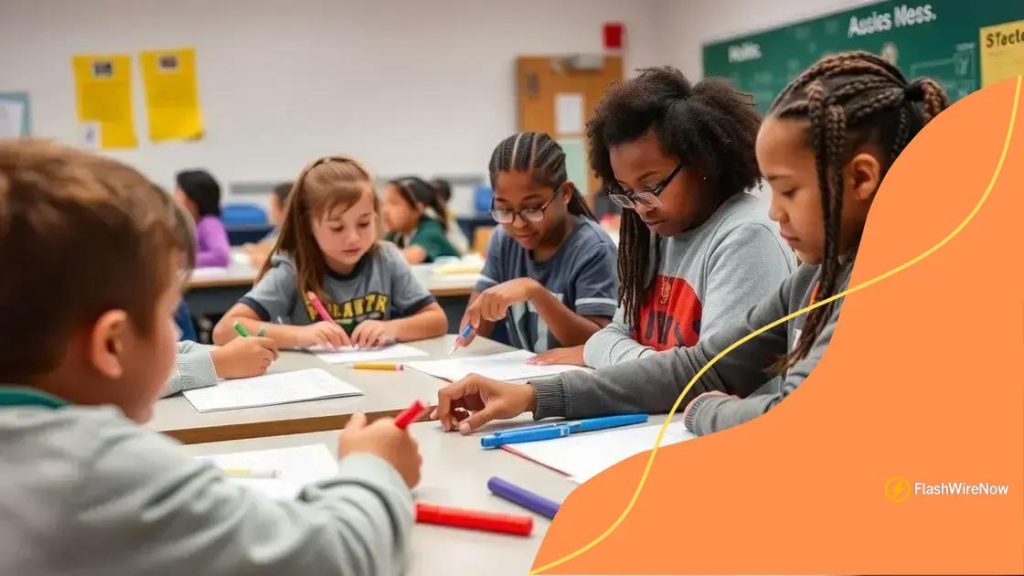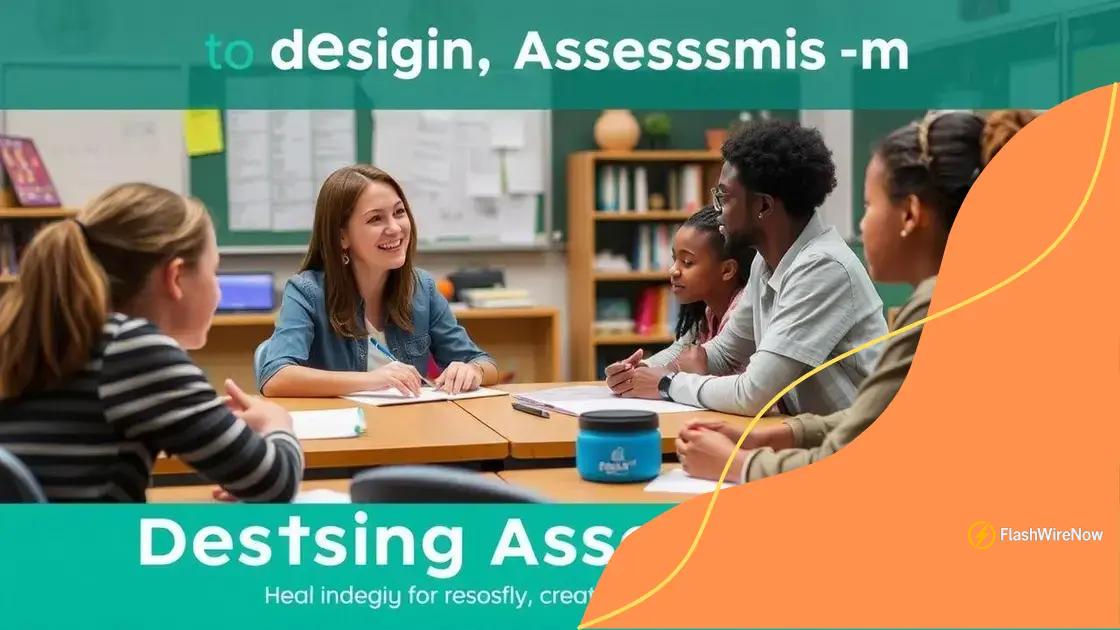Authentic assessment strategies for better learning outcomes

Anúncios
Authentic assessment strategies enhance student learning by reflecting real-world tasks, fostering engagement, and promoting critical thinking while preparing students for future challenges.
Authentic assessment strategies are reshaping how we evaluate student learning. Have you ever wondered how these methods can truly enhance engagement and effectiveness? Let’s dive into what they involve and their impact on education.
Anúncios
Understanding authentic assessment
Understanding authentic assessment is essential for educators who want to enhance student learning experiences. These assessments reflect real-world applications, engaging students in tasks that mirror the challenges they will face outside the classroom.
One key aspect of authentic assessments is their ability to promote deeper understanding and critical thinking. Rather than relying solely on traditional tests, authentic assessments allow students to demonstrate their knowledge in practical ways. This makes learning more relevant and meaningful.
Characteristics of Authentic Assessments
Authentic assessments share several important characteristics. They:
Anúncios
- Require students to apply knowledge in real-life scenarios.
- Encourage creativity and innovation.
- Involve self-assessment and reflection.
- Focus on skills that matter in real-world contexts.
By integrating these characteristics, educators can create assessments that not only evaluate student performance but also foster essential life skills. Students often find these assessments more motivating and engaging compared to traditional methods.
Examples of Authentic Assessment
Examples of authentic assessments can vary widely, catering to different subjects and learning objectives. Some common strategies include:
- Portfolios that showcase students’ work over time.
- Presentations that require research and critical analysis.
- Real-world projects, such as community service initiatives.
- Simulations or role-playing exercises relevant to the subject matter.
These examples illustrate how authentic assessment strategies can transform an ordinary classroom into a dynamic learning environment, preparing students for future challenges.
Moreover, benefits of using authentic assessments extend beyond immediate academic outcomes. They help students develop confidence and competence in their abilities, which are crucial for lifelong learning.
Benefits of using authentic assessment strategies
Benefits of using authentic assessment strategies are vast and impactful for both students and teachers. These strategies enhance the learning experience by making assessments more relevant and engaging.
One of the primary benefits is that authentic assessments promote critical thinking. Unlike traditional tests, which often focus on rote memorization, these strategies encourage students to analyze and apply their knowledge in real-world contexts. This approach helps deepen their understanding and retention of the material.
Enhanced Engagement
Students are generally more motivated when they see the relevance of what they are learning. Authentic assessments create opportunities for:
- Real-life applications of knowledge.
- Increased collaboration among peers.
- Opportunities for creativity and self-expression.
- Connection between schoolwork and life outside the classroom.
Because students find these assessments more interesting, their overall engagement levels typically rise. Increased engagement leads to better focus and commitment to learning.
Development of Key Skills
Another significant benefit of authentic assessments is the development of essential skills. These assessments often require students to work on:
- Problem-solving abilities.
- Communication skills.
- Time management and organization.
- Self-assessment and reflection on their learning.
These skills are crucial for success in today’s fast-paced and complex world. When students practice them through authentic assessments, they gain confidence in their abilities.
Moreover, teachers benefit from using authentic assessments as well. They can gain valuable insights into each student’s understanding and areas needing improvement. This information allows for more tailored instruction, meeting the individual needs of students.
Overall, the benefits of using authentic assessment strategies create a win-win scenario for both educators and learners, fostering a more dynamic educational environment.
How to design effective assessments

How to design effective assessments is crucial for enhancing learning experiences. When assessments are well-designed, they lead to better insights into student understanding and facilitate skill development.
A successful assessment starts with clear objectives. Educators need to ask themselves what specific skills or knowledge they want students to demonstrate. These objectives should align with curriculum standards, making assessments more relevant.
Key Elements of Effective Assessments
To ensure your assessments are effective, consider these key elements:
- Clearly defined learning goals.
- Diverse assessment methods that cater to different learning styles.
- Opportunities for self-assessment and reflection.
- Realistic scenarios that mimic real-life applications.
Incorporating a variety of methods is essential. For instance, you can use projects, presentations, or practical demonstrations alongside traditional quizzes. This approach helps engage students and addresses different strengths.
Involving Students in the Process
Another effective strategy is involving students in the assessment design process. Encourage them to contribute ideas on what types of assessments they find meaningful. This can increase their investment in the learning process and make assessments more enjoyable for everyone. When students feel their voices are heard, they are more likely to take ownership of their learning.
Feedback is a vital part of effective assessments. Providing timely and constructive feedback helps students understand their performance and areas for improvement. It also fosters a growth mindset, encouraging them to embrace challenges. Set aside time for one-on-one discussions where students can reflect and ask questions about their work.
When designing effective assessments, also consider the balance between assessing knowledge and skills. Both are important for student success and should be represented in assessment designs. By focusing on comprehensive evaluations, teachers can provide students with a well-rounded educational experience that prepares them for future challenges.
Real-world examples of authentic assessments
Real-world examples of authentic assessments illustrate how these strategies can be applied in various educational settings. By using real-world scenarios, educators can create engaging assessments that enhance student’s learning experiences.
One common example is the use of project-based learning. In this approach, students work on projects that address real issues in their communities. For instance, a class might investigate local environmental problems and develop a plan to promote sustainability.
Case Studies
Another effective method is utilizing case studies that require students to analyze and solve complex problems. This method fosters critical thinking and allows them to apply theoretical knowledge in practical situations. A business class might analyze a startup’s strategy, discussing what worked and what didn’t.
Simulations
Simulations are also powerful tools for authentic assessments. In a science class, students might conduct an experiment to mimic real-world scientific processes, collecting data and drawing conclusions as practicing scientists do. Simulations enable students to experience the processes professionals use in their fields.
Role-playing is another engaging assessment strategy. For example, students can assume roles such as historical figures or community leaders, allowing them to understand perspectives and decisions in a deeper way. This method can make history lessons more vivid and memorable.
Furthermore, portfolios are used to showcase a collection of a student’s best work over time. Instead of just completing tests, students can assess and present projects that reflect their learning journeys. Portfolios demonstrate how students have grown and what skills they have acquired throughout the course.
By implementing such authentic assessments, educators not only assess student learning but also motivate and engage them through relevant and meaningful tasks. These real-world applications make learning exciting and impactful.
Tips for implementing authentic assessments in the classroom
Tips for implementing authentic assessments in the classroom can greatly improve the learning experience for students. These strategies make assessments more relevant and engaging, promoting active participation.
Start by setting clear goals. Before creating any assessment, define what you want students to learn. Establishing clear objectives will guide your assessment design and ensure that it aligns with educational standards.
Engage Students in the Process
Involve students in the assessment creation. This method encourages ownership of their learning and can lead to more meaningful assessments. Ask for their opinions on the types of assessments they find valuable, such as projects or group work.
Diverse Assessment Methods
Utilize a range of assessment methods to cater to different learning styles. This can include:
- Portfolios that showcase students’ best work over time.
- Group presentations where students can collaborate and share ideas.
- Simulations that replicate real-world situations relevant to their studies.
- Creative projects that allow for artistic expression.
By varying methods, you can better engage each student and assess multiple skills. It’s important to keep assessments flexible and adaptable to meet evolving needs.
Provide Feedback and Reflection Opportunities
After assessments, give constructive feedback. This helps students understand their strengths and areas for improvement. Encourage self-reflection to promote a growth mindset. Ask students to reflect on what they learned and how they can apply it in the future.
Create an environment that supports risk-taking and encourages students to explore new ideas without fear of failure. This can be achieved by valuing effort and progress as much as final results.
Additionally, consider using technology to aid in delivering and assessing authentic assessments. Tools like online portfolios and educational apps can make the assessment process more interactive and organized.
FAQ – Frequently Asked Questions About Authentic Assessment Strategies
What are authentic assessments?
Authentic assessments are evaluation methods that mimic real-world tasks, allowing students to demonstrate their skills in meaningful contexts.
How can I implement authentic assessments in my classroom?
To implement them, set clear goals, involve students in the assessment process, and use diverse methods like projects and presentations.
What are the benefits of using authentic assessments?
They promote critical thinking, increase student engagement, and allow for skill development that prepares students for real-life challenges.
How important is feedback in authentic assessments?
Feedback is crucial as it helps students understand their strengths and areas for improvement, fostering a growth mindset.





